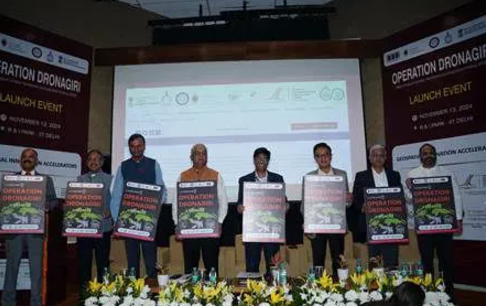Operation Dronagiri
Professor Abhay Karandikar, Secretary of the Department of Science and Technology, introduced Operation Dronagiri, which aligns with the National Geospatial Policy 2022. It aims to showcase geospatial technologies to enhance citizens’ quality of life and streamline business operations.
Objectives of Operation Dronagiri
Operation Dronagiri focuses on three key sectors: Agriculture, Livelihoods, and Logistics and Transport. The initiative will be implemented in five states: Uttar Pradesh, Haryana, Assam, Andhra Pradesh, and Maharashtra. Pilot projects will demonstrate the integration of geospatial data in these sectors.
The project will involve various stakeholders, including government departments, industries, corporates, and startups. This collaborative approach aims to create a robust foundation for a nationwide rollout. Engagement from the private sector is crucial for the project’s success.
Integrated Geospatial Data Sharing Interface (GDI)
An important component of Operation Dronagiri is the Integrated Geospatial Data Sharing Interface (GDI). This platform enables seamless access and sharing of spatial data. It supports urban planning, environmental monitoring, and disaster management. GDI employs advanced data exchange protocols and ensures privacy preservation.
Benefits of GDI
GDI facilitates efficient data processing and analysis. It unlocks actionable insights for stakeholders. This capability enhances collaboration among organisations. Consequently, it leads to faster responses in infrastructure monitoring and disaster relief efforts.
The nationwide expansion of Operation Dronagiri will follow a Public-Private Partnership (PPP) model. This strategy mirrors the successful deployment of the Unified Payments Interface (UPI). Industry involvement will be vital in transforming the geospatial sector.
Importance of the Private Sector
Dr. Srikant Sastri brought into light the private sector’s role in making geospatial data accessible. Startups will contribute to turning data into actionable solutions. The focus is on delivering socioeconomic benefits to communities.
Technological Innovation Hubs (TIHs)
Professor K N Satyanarayana discussed the role of Technology Innovation Hubs (TIHs) in encouraging geospatial innovation. TIHs will accelerate the development and implementation of geospatial technologies. Their involvement is essential for driving growth in this sector.
Operation Dronagiri represents a very important step in India’s journey toward becoming a global leader in geospatial technology. The initiative seeks to liberalise geospatial data and enhance infrastructure. Through these efforts, India aims to leverage geospatial innovations for public good.
Important Facts for Exams:
- Operation Dronagiri: This pilot project aims to demonstrate geospatial technology applications. It focuses on improving citizens’ quality of life and streamlining business operations in India.
- Integrated Geospatial Data Sharing Interface (GDI): GDI facilitates seamless data access and sharing. It supports urban planning and disaster management while ensuring privacy through advanced data exchange protocols.
- National Geospatial Policy 2022: This policy aims to position India as a global leader in geospatial technology. It promotes the liberalisation of geospatial data and infrastructure development across various sectors.
Month: Current Affairs - November, 2024
Category: Science & Technology Current Affairs


